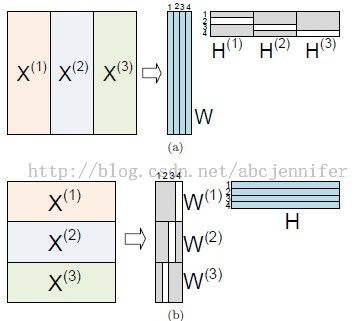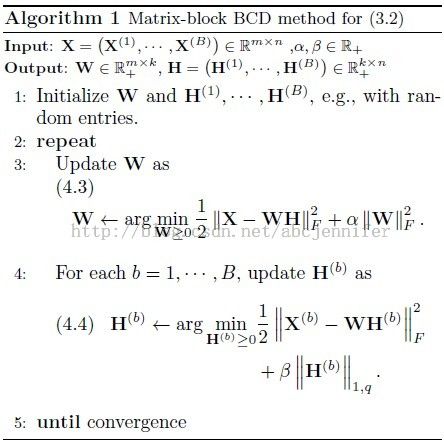Comprehensions on Group NMF
Comprehensions on Group NMF
Rachel Zhang
1. Brief Introduction
1. Whyuse Group Sparsity?
An observation that features or data items withina group are expected to share the same sparsity pattern in their latent factorrepresentation.
假设的Group sparsity就是从属于同一个group的数据项或者特征在low-rank 表示中有相似的sparsity pattern.
2. Differencefrom NMF.
As a variation of traditional NMF, Group NMF considersgroup sparsity regularization methods forNMF.
3. Application.
Dimension reduction, Noise removal in text mining,bioinformations, blind source separation, computer vision. Group NMFenable natural interpretation of discovered latent factors.
4. What is group?
Different types of features, such as in CV: pixelvalues, gradient features, 3D pose features, etc. 同种feature组成一个group
2. Relatedwork
5. Relatedwork on Group Sparsity
5.1. Lasso(The Least Absolute Shrinkage and Selection Operator)
l1-norm penalized linear regression
5.2. GroupLasso
Group sparsity using l1,2-norm regularization
(2)
where the sqrt(pl)terms accounts for the varying group sizes
5.3. Sparsegroup lasso
(3)
5.4. Hierarchicalregularization with tree structure,2010
R. Jenatton, J. Mairal, G. Obozinski, and F. Bach. “Proximal methods forsparse hierarchical dictionary learning”. ICML 2010
5.5. Thereare some other works focus on group sparsity on PCA
6. Relatedworks on NMF
6.1 AffineNMF: extending NMF with an offset vector. Affine NMF is used to simultaneouslyfactorize.
3. Problem to Solve
Consider a matrix X∈ Rm×n .Assume that the rows of Xrepresent features and the columns of Xrepresent data items.
7. In standard NMF, we are interested in discovering two low-rankfactor matrices W and H by minimizing an objective function:
constrain W>=0 and H>=0
8. Group structure and Group sparsity
In this figure, (a)中group分sample, 对于basis W, 一个group内系数H的sparsity相同; (b)中group分feature,group sparsity体现在latent component matrices的构造中。
9. In group NMF, objective function:
That is, the l1,q-norm of a matrix is the sum ofvector lq-norms of its rows.
所以,||Y||1,q 的惩罚项希望得到Y中的0行越多越好。
在这里,b个类,每一类的X(b)和H(b)不同,所以obj function希望使得H(b)中有尽可能多的0行, 刚好符合我们的group sparsity。
4. Optimization Algorithms
With mixed-norm regularization, the minimization problembecomes more difficult than the standard NMF problem. We here propose twostrategies based on the block coordinate descent (BCD) method in non-linearoptimization. In both algorithms, the l1,q-normterm is handled via Fenchel duality.
10. Thefirst method – Matrix-block BCD method for (5)
In this method, a matrix variable is minimized ateach step fixing all other entries.
(4.3) is solved by nonnegativity-constrainedleast squares (NNLL)
Now considerthe problem in (4.4), it can be rewritten by
其中第一项可微,导数连续,第二项convex。那么可用一个凸优化解决。
Algo 2 是(4.7)的一种解决方法(variant of Nesterov’s first order method),其中主要需要解决的是(4.6) 按行更新,可以看做解决:
而这个非负约束可以由(4.9)消除掉(其解为(4.8)的全局最优解)
其证明见Reference [1]. 而(4.9)就可以由(4.11) 解决了:
where ||·||q* isthe dual norm of ||·||q.
q=2时,||·||q*=||·||2
q=∞时,||·||q*=||·||1
11. The secondmethod is a BCD method with vector blocks; that is, avector variable is minimized at each step fixing all other entries.
Recent observations indicate that the vector-block BCD method is also very efficient, oftenoutperforming the matrix-block BCD method. Accordingly, we develop thevector-block BCD method for (5) as follows.
In the vector-block BCD method, optimal solutions tosubproblems with respect to each column of W andeach rows of H(1), ··· ,H(b) are sought.
The solution of (4.14) is given as a closed form:
Subproblem (4.15) is easily seen to be equivalent to
Which is a special case of (4.8)
12. Remark on the two optimizing methods:
Optimization Variables in (5): {W, H(1),…,H(B)}
Matrix – BlockBCD method: divides the variables into (B+1) blocks: W, H(1),…, H(B)
Vector –Block BCD method: divides the variables into k(B+1) blocks, represented by thecolumns of W, H(1),…, H(B)
Both methodseventually rely on dual problem (4.11).
5. Result:
6. Reference
1. JinguKim et al. “Group Sparsity in Nonnegative Matrix Factorization”
2. NMF代码http://www.csie.ntu.edu.tw/~cjlin/nmf/
3. “Algorithmsfor NMF” http://hebb.mit.edu/people/seung/papers/nmfconverge.pdf
4. NMFtoolbox http://cogsys.imm.dtu.dk/toolbox/nmf/
5. "Group Nonnegative Matrix Factorization for EEG Classification"


